Petunias in flower beds and pots are one of the very popular garden flowers. They are abounding bloomers in almost every color but true blue. They have wide, conical, flaring at the broad end-shaped flowers and branching foliage that is hairy and sticky. Within the petunia genus, there is a great variety. Most of these are sold as hybrids and can have single or double blooms. These flowers have ruffled or smooth petals with striped, veined, or solid colors, mounding or cascading growth habits, and even fragrances.
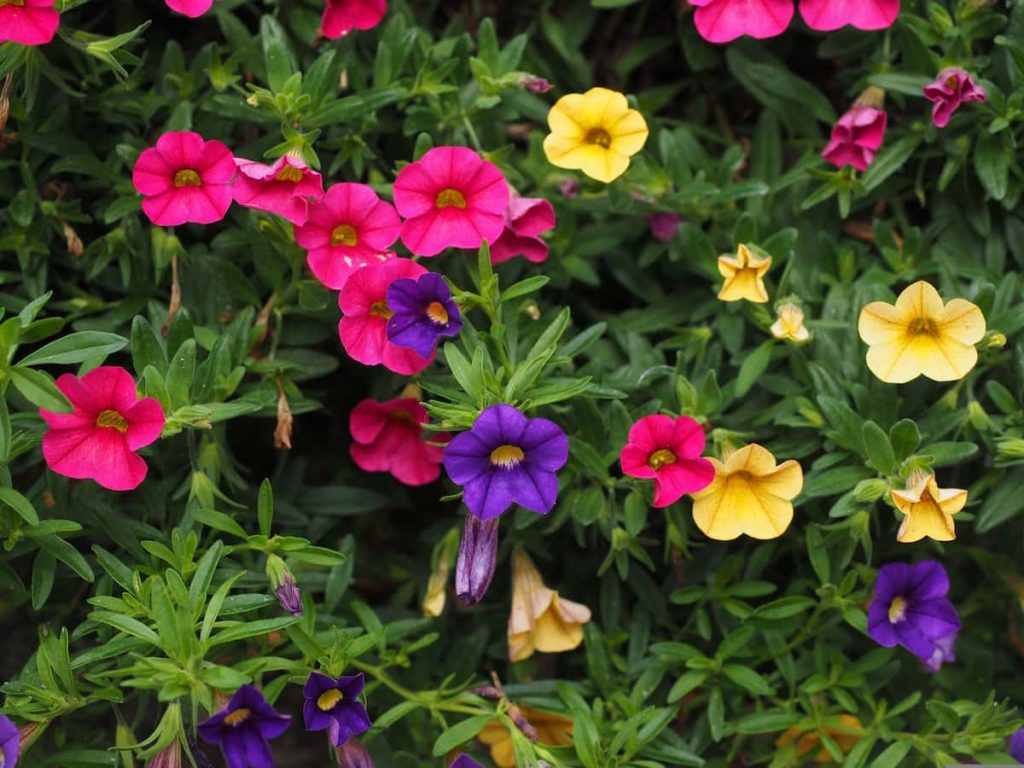
Petunias are fast-growing bloom plants that will reach full size by late spring. When to plant petunias depends on the area projected last spring frost date as the plants must not be exposed to any frost. Petunias bloom all summer by giving them enough sun, water, and fertilizer.
These plants need deadheading the spent blooms and pruning back scraggly growth. In cold climates, petunias are annuals, i.e., they only bloom once per year. Petunias will come back yearly within their warmer growing zones but still do not last very long. It will bloom flowers for a maximum of about three years. However, they will self-seed for continued growth.
How to plant and care for petunias
Types of petunias
Many types of petunias range in appearance and care needs. These petunia types are split into five main groups based on their characteristics.
Grandiflora
Grandifloras typically can not produce as many flowers as the other types, but the flower size is big. These plants have big and showy, between three and five inches across. These plants generally have an upright, mounded form, typically growing to a maximum height of 15 to 24 inches and can spread up to 36 inches. These Grandiflora petunias and others have long, flexible, trailing stems referred to as pendulum-type petunias. They struggle in hot, humid climates. Also, Grandiflora petunias require deadheading to maintain their good looks.
Grandiflora variety is less firm and can be affected by heat and rain. It is available in a various range of colors. The most common cultivar type of Grandiflora petunias include,
- Aladdin
- Amore
- Aphrodite
- Avalanche
- Cascade
- Cascadias
- Constellation
- Daddy
- Diamond
- Dreams
Multiflora
Multiflora produces small and compact flowers compared to the Grandiflora petunia. It grows in various shapes and sizes, about half the size of the Grandiflora flowers. The flowers of this variety can withstand different weather conditions. An advantage to choosing this petunia type is that these flowers are self-cleaning. The spent blooms will fall without deadheading, which makes them the best choice for large plantings. They hold up better in the rainy season than Grandiflora petunias. These petunia varieties bloom smaller flowers than the Grandiflora types, but they make up for it by producing more flowers.
Multifloras will have single or double blooms. These cultivars are well known for presenting a wide range of colors, and the plants grow more quickly than Grandiflora petunias. The most common cultivar type of multiflora petunias include,
- Southern star
- Carpet
- Horizon
- Carpet
- Easy wave
- Espresso
- Hurrah
- Mambo
- Mirage
- Pearls
In case you missed it: Kentucky Vegetable Planting Calendar (KY): Month Wise Guide for Fall, Winter, Spring, Summer, Zone 6, and Zone 7
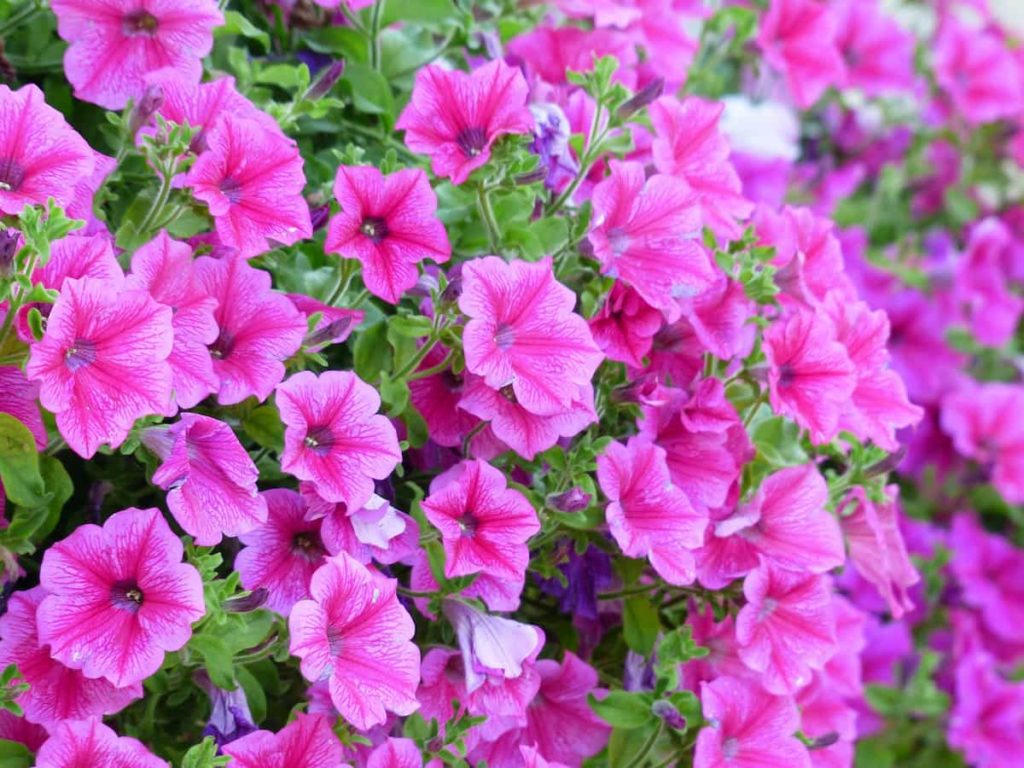
Floribunda
These petunias variety fall somewhere in the middle of Grandiflora and Multiflora petunias. They can produce many moderately sized blooms. Floribunda plants are generally grouped with the multifloras and some like those in the wave series. These plants exhibit the best qualities of Grandiflora and Multiflora petunias, with lots of large blooms, can withstand rainy weather, and can increase disease resistance.
They can grow a maximum height of eight to 15 inches and spread 10 to 12 inches, though some plants are more compact. These types are not typically self-cleaning and usually require some deadheading or pruning. The most common cultivar type of Floribunda petunias include,
- Celebrity
- Double madness
- Double wave
- Freedom
- Frillytunia
- Horizon
- Pretty flora
- Prism
- Madness
- Double wave
Milliflora
Milliflora is one of the more recent introductions, and these small petunias have smaller, single blooms, generally one and a half inches in maximum diameter. Even though the size is small, these plants will bloom on large counts. Milliflora plants will be covered in flowers almost throughout the season. The flowers on this variety of petunias stretch less than 2 inches across. But they are abundant and long-lasting.
This variety came quite late, and this low-maintenance variety is ideal for hanging baskets and containers. These are also good for small gardens, and most milliflora varieties are self-cleaning, so they do not require deadheading. The dwarf plants are very compact than other varieties, with a mounding form. They grow just eight inches in height and wide on average. The most common cultivar type of milliflora petunias include,
- Fantasy
- Flash forward
- Picobella
- Shock wave
- Tiny tunia
- Vivini
Trailing/spreading
This new addition to the petunia family features 2 inches of flowers across. The plant will spread up to 2-4 feet by the end of the season. This variety can be well grown in both containers and as a ground cover. These types of petunias can withstand heat and drought very well. Trailing petunias have a low ground, spreading growth habit. They look awesome as ground cover or spilling over the edges of pots or containers. This variety can grow vigorously and spread enthusiastically.
A single plant can cover 10 square feet of garden beds or borders in a single season, typically reaching only about four to six inches in height. Particularly they are heat and drought-tolerant and do not usually require deadheading to look good. Several Wave series plants are generally included in this category. The most common cultivar type of trailing petunias include,
- Blanket
- Double blanket
- Hang out
- Supertunia
- Tidal wave
- Velvet
In case you missed it: How to Plant and Care for Hydrangeas: Steps to Grow Hydrangeas for Beginners

Soil requirements and preparation for growing petunias
Petunias grow well in fertile soil, which drains water well. And the pH value should be pH 6.0 to 7.0, neutral to slightly acid. Light and sandy soil are ideal. Petunias grow well in peat-free, multi-purpose potting compost for pots and containers. Choose a compost that includes water-holding granules for raised containers like hanging baskets and window boxes exposed to drying sun and wind.
Break up the soil by plowing down 6 or 8 inches, blend some organic matter, and then level it. Dig a small hole for every seedling about the size of its container. Prepare the soil by mixing plenty of well-rotted compost or soil conditioner before planting.
How to grow petunias from seed
It is most common to purchase young petunia plants from a nursery. But it can be worth growing petunias from seed, especially if you plan to grow for a particular variety. The steps for planting petunias from seed include,
- Scatter the petunia seeds on top of a moist seed-starting mix. Press down them gently, and do not bury them as they need light to germinate.
- Cover the seeds with a plastic sheet, and place them in a warm spot but out of direct sunlight. The seedlings can be developed within seven to 10 days.
- Once seedlings are developed and emerge, remove the plastic covering.
- They can be transplanted into their pots when the seedlings have three true leaves until they are ready to be transplanted outdoors.
When to plant petunias
Buying young plants from a nursery that sells petunias in flats is easiest. Select plant variety that is short and compact. Leggy petunias with tons of flowers already will not settle in as fast. If you plan to grow petunias from seed, start the seeds indoors 8 to 10 weeks before the spring’s last frost date. Plant the petunias outdoors after the spring’s last frost date, but closely observe the weather and protect the plants from late frosts.
How to plant petunias
Petunia seeds are very small, like dust, and need lots of light to germinate. When the young plants have three sets of true leaves, plant them outside with a spacing of 1 foot apart. If planting petunias in containers, use a potting mix to drain the water well. Petunias can withstand heat fairly, so do not worry about watering them frequently. Carefully pull the seedling from its container, set it in a dug hole, and then fill the soil around the roots, pressing gently.
Do not bury the seedling deeper into the soil than it was in the previous container. Water the seedlings generously. Watering once per week is enough unless there are prolonged periods of drought. Do not water shallowly, as this encourages shallow roots. Fertilize petunias monthly with a balanced fertilizer that supports fast growth and heavy blooming plants. Double-flowered cultivars can be fed with a biweekly dose of fertilizer.
Where to plant
For the best performance, plant the petunias in full sun, at least six hours a day. They will withstand some shade but may not flower as prolifically. Petunias grow well in direct sunlight, unlike their lookalikes, impatiens flowers. While partial shade will work, aim for a planting site with at least six hours of sun per day. Like most plants, petunias need fertile, well-draining soil with a slightly acidic pH.
The ideal soil pH value for growing petunias should be between 6.0 and 7.0, which is achieved by incorporating organic materials or fertilizer. To ensure that the soil has proper ventilation, blend organic matter into the soil, such as compost, into the first eight inches with your hands. Dig holes about the same size as the starter pots before planting.
In case you missed it: How to Grow Snake Plants: A Guide to Planting and Care
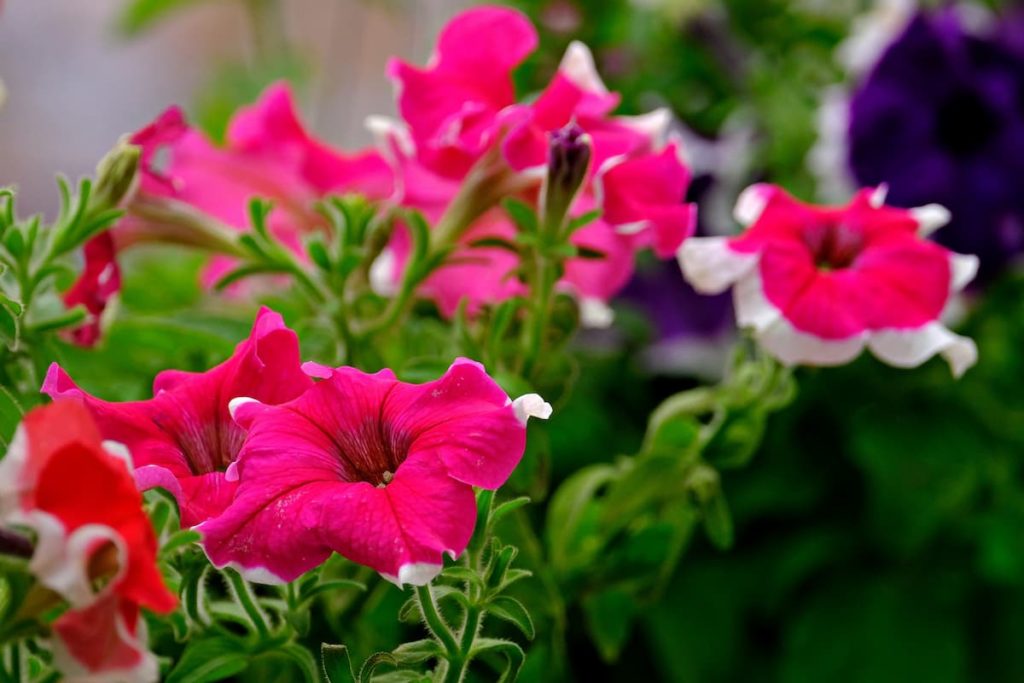
Care for petunias
Light
Most petunia types like to grow in full sun, for at least six hours of direct sunlight on maximum days. But in the summer heat, especially from the strong afternoon sun, the partial shade will help keep them refreshed and blooming better.
Planting and soil
Petunias plants are well grown in light, fertile soil that provides good drainage. They can withstand a wide variety of soil types as long as they are well-draining. Plus, they like to grow in slightly acidic soil. Plant the petunias outside after the threat of frost has passed, as the soil should be warm and workable. Plants should be spaced approximately a foot apart.
Water
Like many flower plants, petunias do not like to be dry for a long time. However, they also do not like to grow in soggy soil, which can rot their roots. Plus, Overwatering can result in leggy plants with few flowers. Generally, it is sufficient to feed beds weekly with 1 to 2 inches of water when there is no rainfall. However, some spreading varieties of petunias and petunias in pots typically need more frequent and deep watering. Ensure not to the soil dry out more than 2 inches down.
Temperature and humidity
The best temperatures for petunias growth are roughly 16°C to 24°C during the day and 13°C to 19°C at night. They can also withstand low temperatures, but frost and freezing temperatures will damage and ultimately kill the plants. Low to moderate humidity levels are best suited for these flowers.
Fertilizer
At the time of planting, feed the petunias with a balanced fertilizer. It is also helpful if some compost is added to the soil. Fertilize the petunias every two to three weeks with a liquid fertilizer made for flowering plants starting in July and continuing till the plants decline in the fall. Some of the spreading varieties of petunias need weekly fertilization.
Potting and repotting petunias
Use a quality all-purpose potting soil mix for petunias. Petunias in pots or containers can be spaced more closely than in flower beds for a fuller look. But do not plant more than three plants in a 12 inches wide and deep container. The container should have ample drainage holes.
Any pot material should be fine, whether terracotta or plastic, but opt for a light color to prevent the roots from overheating. It is good to start with a container that can accommodate the mature petunia size to avoid repot. Disturbing the root system during the growing season might affect blooming.
How to get petunias to bloom
The primary season for petunias blooming is in the summer, though they will start in the spring and stretch into fall until the temperature drops and the frost season starts. Older petunia varieties generally need deadheading to continue blooming at their best throughout the summer. However, various newer varieties do not require deadheading, though they will still benefit from it to maximize their blooms.
Leave the spent blooms on the petunia plant to self-seed. But if you want all of the plant’s energy to go toward optimal flowering, deadheading is ideal. Trimming back a leggy petunia plant in midsummer can also encourage fresh, healthy growth, producing more branching and blooms.
In case you missed it: Indiana Vegetable Planting Calendar/Guide (IN): Month Wise, Fall, Winter, Spring, Summer, Zone 5, and Zone 6
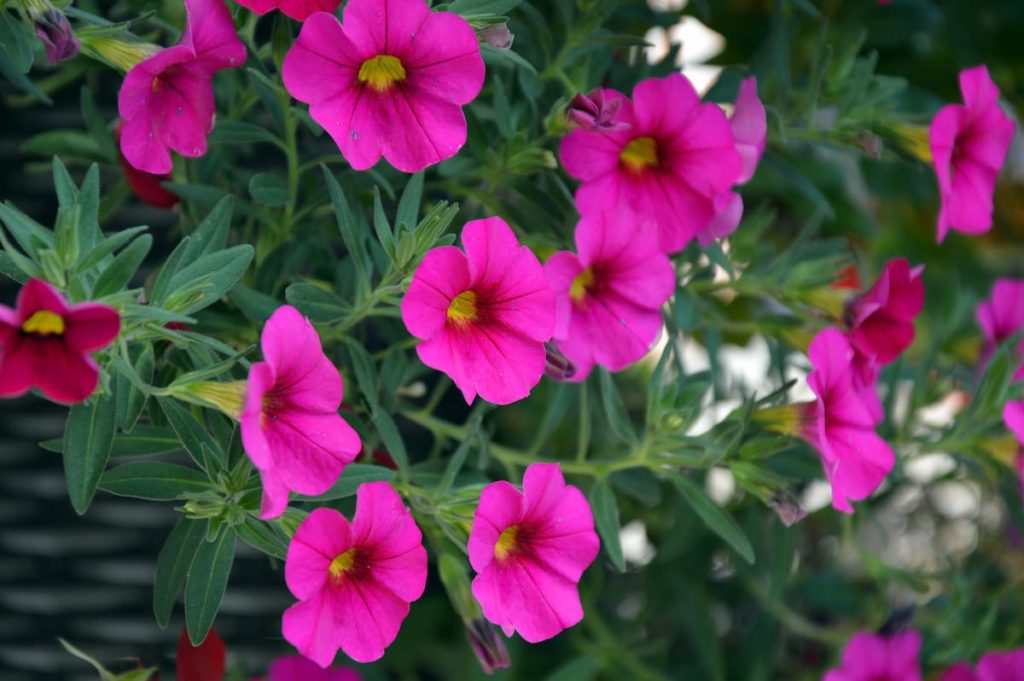
Pruning petunias for better growth
Removing deadheads
Examine the plants once a week to spot browned, withered flowers. Pinch and separate the deadheads from plants. Position the forefinger and thumb about 0.25 inches above the bud of a deadhead. Pinch the wilted bloom and pull it gently while removing it. Ensure to remove the entire head of the flower, not just the petals. Removing deadheads will prevent the plants from going to seed, preventing them from blooming.
Trim stubborn deadheads with pruning shears. If a deadhead can not be removed by simply pinching it, use pruning shears to trim it away. Position the shears 0.25 inches below the flower’s bud, near the stem, and carefully snip it
Cutting down petunia plants
Cut sinking stems to encourage regrowth. If you identify stems that look limp and are not growing flowers, trim them immediately. Use sharp pruning shears to separate the stems from the plant at their halfway point. This pruning should leave at least 2 inches of stem from the base of the plant. As the entire stem is separating from the plant, there is no need to remove any leaves from the stem.
Trim stems down to 2 inches from the base if they are damaged. Use sharp pruning shears to cut away as much of the damaged stem as possible. Ensure that at least 2 inches of it remain above the soil surface. If you have a large crop, cut down a third of the plants every other week. Cut down the plants regularly, even though the stems are not damaged, to promote greater growth. Each trimmed stem can branch out and will give 3 or 4 new blooms within 2-3 days. Remove the bulk stems, leaving at least 2 inches to regrow. Here is a general pruning schedule based on a petunia planted in spring.
At the beginning of July
Give the plant a light pruning after its rapid growth in May and June. For this pruning, you will want to cut back about one-third of the branches and focus on the ones growing long and rambling. This pruning will stimulate new blooms.
Mid-August
Remove the straggly stems, especially long branches, until the plant looks shaped. This pruning is similar to light pruning in July, do not cut back more than one-third of the branches.
Mid-September
This pruning step will be the last pruning of the season. Follow the same approach as the previous prunings, leaving about two-thirds of the plant alone.
Propagating petunias
Sowing seeds
Propagation by sowing is very successful and easy. You can harvest the seeds if you already have petunias in your garden. For example, the salmon-colored variety salmon wave is particularly easy to grow from seed and even rain-resistant.
- The first step in propagating seeds is harvesting seeds from the petunia flowers. While harvesting seeds, collect the seed pod when they are light brown and closed.
- Dry these capsules in a warm and airy place until they burst, collect the small seeds and store them in a cool, dark place.
- Take a container with drain holes at the bottom and fill this container with germ-free sowing soil.
- Scatter the seed evenly over the soil surface in the container.
- Cover the petunia seeds with a thin layer of soil
- Water the seeds with a water sprayer to keep the soil slightly moist.
- Place this container in a bright location without direct sunlight
- Once the seedlings are observed from the soil, transplant them to the outdoor garden after 10-15 days.
Propagating petunias from cuttings
Hanging petunia types are particularly more suitable for propagation by cuttings, as they produce long, strong shoots with the right care. It will not take long for the cuttings to grow their first roots. The cuttings are best cut in the summer.
- Choose a healthy stem and cut as 10 cm long shoots, preferably flowerless.
- Except for the top pair of leaves, remove all leaves and flowers.
- Place the stem in a glass with lime-free water until roots have formed, and then put in pots with soaked growing soil or plant directly in the pots.
- Propagation will be successful when the cuttings sprout at the top.
- Repot into a separate planter and continue to cultivate like adult petunias.
The cuttings may take two to three weeks to develop sufficient roots in the glass with water. While planting directly in pots, the cuttings are inserted a few centimeters deep into the soil, which is then pressed down well.
In case you missed it: Emerging Trends in Agriculture in India: A Guide to Future of the Farming
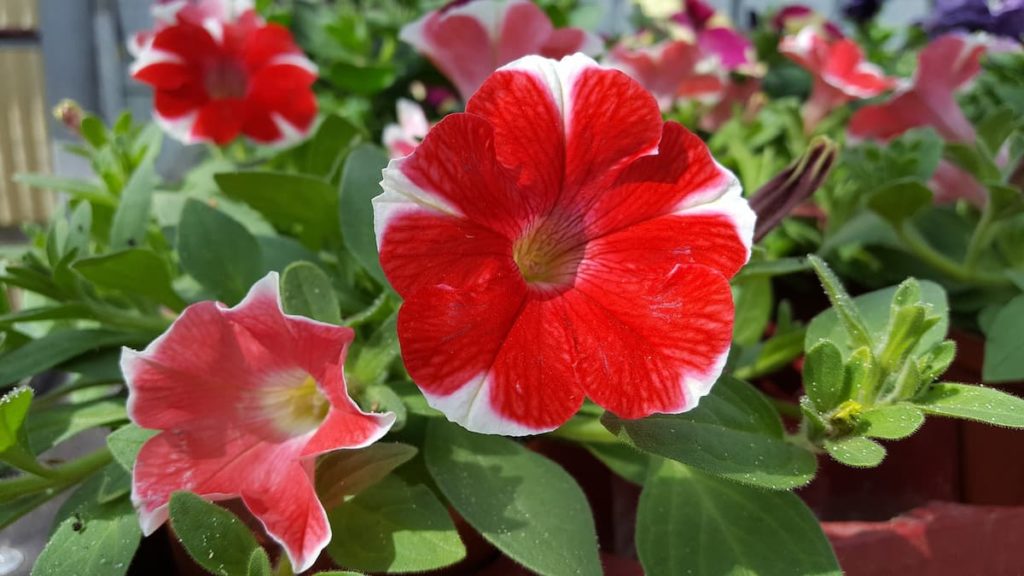
Pests and diseases of petunias
Growing petunias can bring long-term color to the summer landscape and brighten dreary borders with lovely colors. Petunias are grown for their good-looking flowers and are easy to grow. Tobacco budworms, cutworms, slugs, and rabbits eat the leaves and flowers of Petunias. Aphids and Spider mites may also eat Petunias.
Mites
Mites are very small pests that suck the juices directly out of petunia cells. These spider’s cousins may cause leaves to curl and cups or flowers to discolor and stiffen. Spray the petunias with neem oil once a week until all signs of mites are gone.
Caterpillars
Caterpillars chew foliage and buds of the plants, sometimes causing extensive damage. The best solution is to remove them by hand and drown them in a bucket of water daily, or sprays of pesticide applied weekly should knock them out quickly.
Thrips
Thrips can carry viruses to petunias and cause leaves to turn papery or flowers to develop white spots, known as a color break. They can be difficult to see, but they look like tiny, fat ants running around the plants. Neem oil or insecticidal soap will destroy them in a few thorough weekly sprays.
Petunia diseases
Petunias are a popular annual, blooming from spring until the first frost in various colors. These plants can be grown at 6 to 18 inches with flowers of 1 to 6 inches in diameter. However, they can be attacked by fungi such as spore-producing, parasitic organisms such as molds, mildews, smuts, and yeasts. The fungi can wilt, decay, and sometimes even kill the petunias. Two well-known petunia fungi are Botrytis cinerea and Phytophthora parasitic. Root, stem, crown rot, botrytis blight below, powdery mildew, and verticillium wilt are common diseases affecting petunia plants.
What causes petunias to die or not thrive?
Dying and wilting petunias are generally because of fungal diseases such as root rot caused by more moisture around the roots. Petunias require thorough watering once a week and do not tolerate boggy soil from overwatering, which causes petunia’s leaves and flowers to wilt, and results in dying petunias. The reasons that affect petunias growth and health are,
- Lack of light
- Improper soil moisture
- Soil fertility
- Temperature
- Pest or diseases
- End of the life cycle.
- Crops Grown in Summer Season: Best Choices for Summer Gardening
- Organic Pest Control for Tomato Farming
- How to Maximize Sheep Farming Profit
- Broccoli Varieties: Choosing the Right Cultivars for Your Farm
- How to Raise Pigs in Your Own Backyard: A Comprehensive Guide
- Budget Friendly Sheep Shed Ideas: Cheap and Low-Cost Tips
- How Much Do Cattle Farmers Make: Revenue Streams in Cattle Farming
- Management Pests and Diseases in Your Cotton Field
- Sheep Farming Business Plan for Beginners
- Aquaponic Farming at Home: A Step-By-Step Guide
- Profitable Village Farming Business Ideas in 2024
- High-Yield Aquaculture: Fast-Growing Fish for Farming
- Effective Fish Pond Construction Techniques for Beginners
- Irrigation and Water Management in Pineapple Farming
- Blossom to Harvest: Mastering Flowering and Pollination in Papaya Farming
- Pig Fattening Essentials: From Selection to Sale for Beginners
- Raising Wagyu Cattle: A Complete Guide for Premium Beef Production
- Soil Types and Their Water Holding Capacity
- Optimizing Irrigation Schedules for Coconut Groves for Enhanced Yield
- Espresso Your Garden: Coffee Grounds for Healthier Acid-Loving Plants
- The Best Soil Mix for Snake Plants: How to Mix Your Own Snake Plant Soil
- Green Thumb Success: Expert Tips for Cultivating Greenhouse Beans All Year Round
- Bloom All Year Round: The Ultimate Guide to Indoor Hyacinth Care
- Eco-Friendly Gardening: How to Make Liquid Fertilizer from Kitchen Waste
- Ultimate Guide to Grow Anise in Pots: Explore Seed Propagation to Harvesting
- Guide to Raising Chester White Pigs: Discover Breed Facts to Growth Management
- Mastering the Elegance: The Ultimate Guide to Weeping Cherry Tree Care, Planting, and Maintenance
- Ultimate Guide to Planting Garlic in Grow Bags: Growing Strategies for Beginners
- How to Fix Spider Plant Leaf-Related Problems: Natural and Organic Remedies
- 10 Reasons Why Your Tulsi Plant is Shedding Leaves: Home Remedies and Solutions
- Optimizing Growth and Yield: The Advantages of Palm Bunch Ash Fertilizer
- Utilizing Neem Oil Extract as a Natural Pesticide for Hydrangea
- From Soil to Harvest: Various Ways in Which Farmers Can Use AI Tools
- Steps to Encourage and Induce Citrus Flowers: A Comprehensive Guide
- How to Fix Snake Plant Leaf-Related Issues: Natural and Organic Remedies
- Transform Your Garden into a Fragrant Oasis with Raat Ki Rani (Night Blooming Jasmine)
